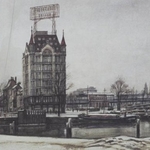Het format van de stad. Een evaluatie van recente Nederlandse stadsgeschiedenissen
DOI:
https://doi.org/10.18352/bmgn-lchr.5710Keywords:
Urban HistoryAbstract
R. Kunst, Leeuwarden 750-2000. Hoofdstad van Friesland; A. van der Schoor, N. Schadee, Stad in aanwas. Geschiedenis van Rotterdam tot 1813; P. van de Laar, Stad van formaat. Geschiedenis van Rotterdam in de negentiende en twintigste eeuw; R.E. de Bruin, 'Een paradijs vol weelde'. Geschiedenis van de stad Utrecht.
The shape of the city. An evaluation of recent historical studies on Dutch towns
Urban history in the Netherlands started roundabout 1970. It was initially promoted by mainly economic and social historians who used concepts derived from geography which centred on town and country relations, urban networks, and migration. The spatial factor was considered to be a core feature, also inside the towns and cities. An alternative view, however, argued that a completely introspective urban history, focussing on one city, would result in more integration. This hypothesis has been proved in a number of recent, more or less integral urban histories, commissioned by several independent municipal authorities in individual cities. They show that a combination of internal and external elements offers the best results with regard to integration.
Downloads

Downloads
Published
Issue
Section
License
Authors who publish with this journal agree to the following terms:
a) Authors retain copyright and grant the journal right of first publication with the work simultaneously licensed under a Creative Commons Attribution 4.0 International (CC BY 4.0) that allows others to share the work with an acknowledgement of the work's authorship and initial publication in this journal.
b) Authors are able to enter into separate, additional contractual arrangements for the non-exclusive distribution of the journal's published version of the work (e.g., post it to an institutional repository or publish it in a book), with an acknowledgement of its initial publication in this journal.
c) Authors are permitted to post their work online (e.g., in institutional repositories or on their website) prior to and during the submission process.
Authors are explicitly encouraged to deposit their published article in their institutional repository.







